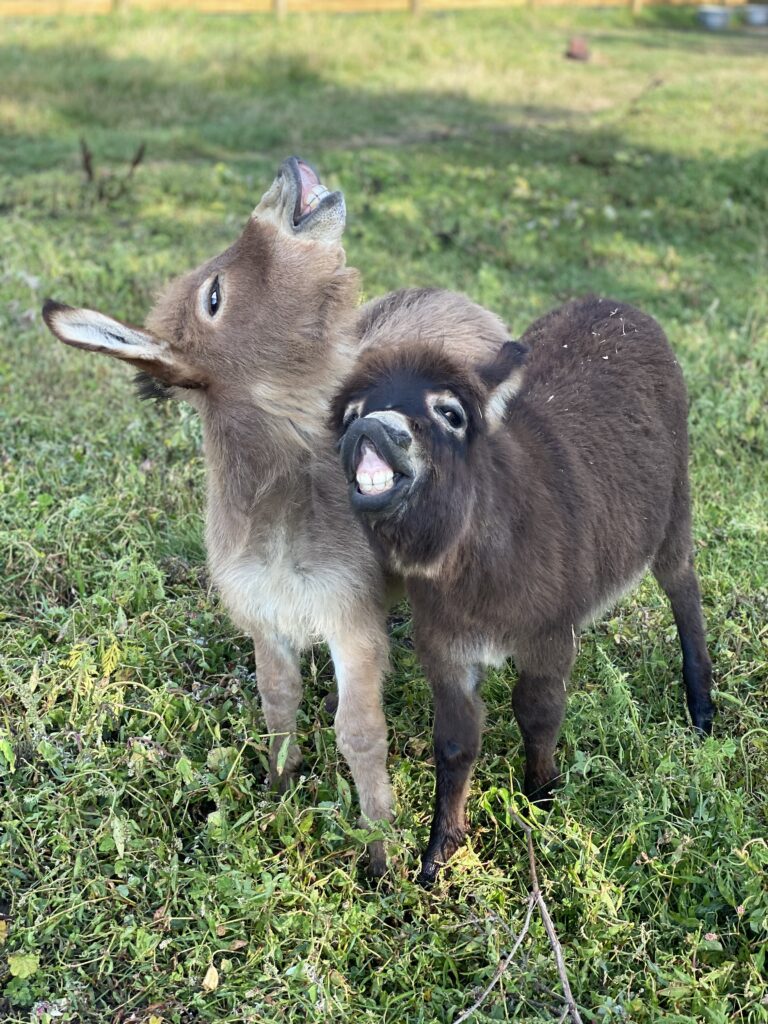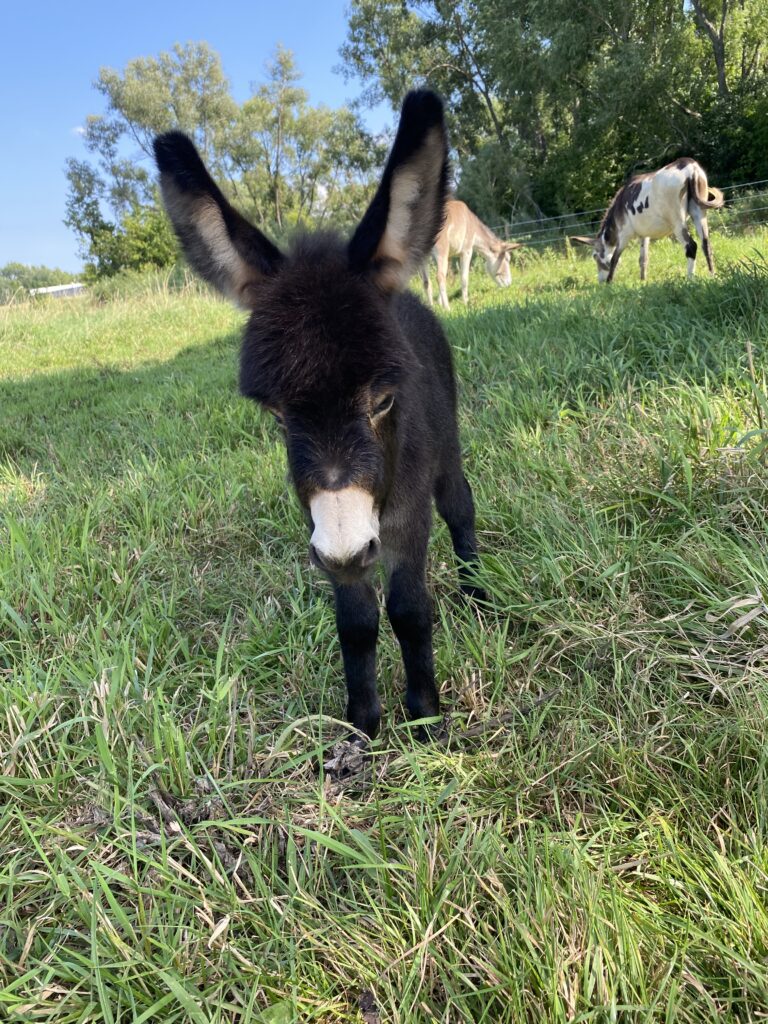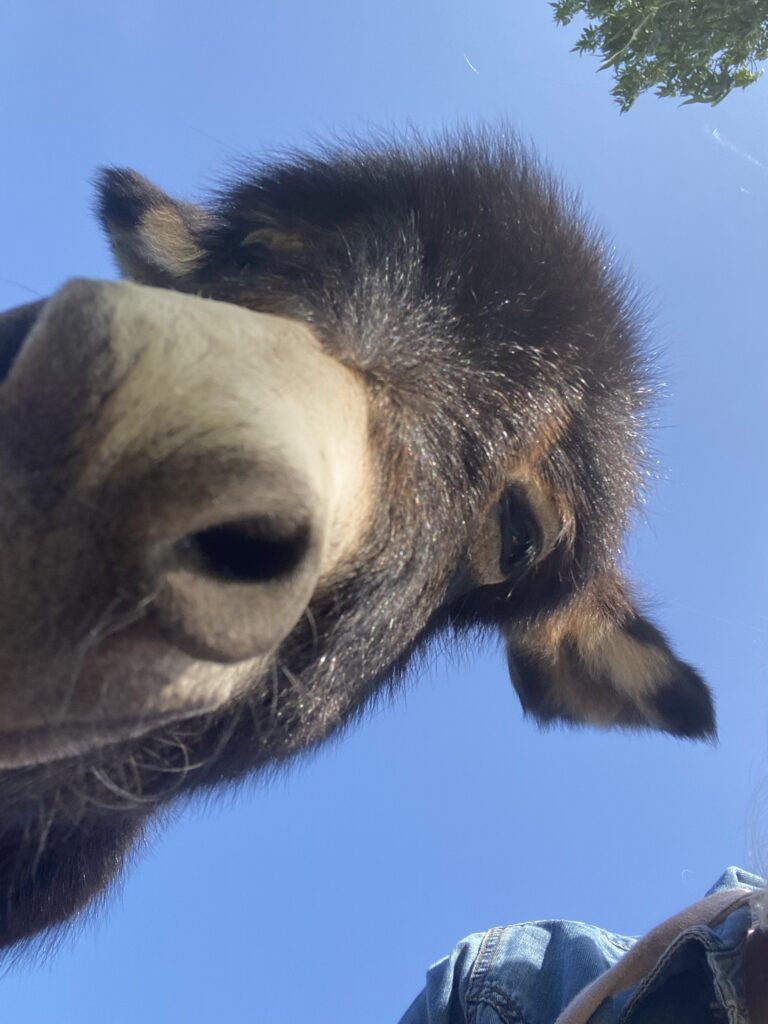
Donkeys are incredibly loyal and protective, largely due to their natural instincts to form bonds and safeguard their herd. In the wild, they live in close-knit groups, relying on each other for safety and survival. Once a donkey forms a connection with a person or another animal, they feel a deep sense of responsibility to protect them from threats.
Donkeys also have a strong need for companionship. Being herd animals, they thrive on social interaction and can become stressed or depressed if left alone. This need for connection is what makes them so loyal—they seek out relationships where they can feel secure and bonded. Their protective instincts, paired with their need for companionship, make donkeys reliable guardians and devoted friends.
The following information is provided by the American Donkey and Mule Society (ADMS).
Miniature Mediterranean: 36″ and under
Standard: 36.1″ to 48″
Large Standard: 48.1″ to 54″ (jennets); 36.1 to 56″ (jacks and geldings)
Mammoth: 54.1″ and above (jennets); 56.1″ and above (jacks and geldings)

If you enjoy horseback riding, you’ll love riding donkeys instead. Horses are good but donkeys are better! Here are just a few good reasons to ride a donkey:
 Why Is My Donkey Laughing?
Why Is My Donkey Laughing?When your donkey flips his lip back in a “horse laugh,” he isn’t amused, he’s “flehmening.” The flehmen response (from the German word flehmen, meaning “to curl the upper lip”), also called the flehmen position or flehmen reaction, is a grimace that most ungulates, cats, and a few other mammals make to explore scent.
When a donkey flehmens, he flips his upper lip back to expose and draw odorants into his Jacobsen’s organ, a pheromone-detecting organ located in the roof of his mouth. Jacks do this to determine whether a jenny is in heat, but both sexes flehmen after sniffing unusual scents, especially the manure or urine of unfamiliar donkeys.

One undeniable difference between horses and donkeys is their neighs and brays. Donkey vocalizations, say researchers David G. Browning and Peter M. Schiefele, are unique among members of the equine clan because sound is produced during both air intake (the hee) and air outflow (the haw). These vocalizations consist of a series of emanations that cease only when the donkey becomes short of breath. The acoustic character, duration, and sequence (some he-haw, while others haw-hee) are unique to each animal.
A donkey’s hearing isn’t quite as acute as a dog’s but is much better than that of a human (or even a horse). When a donkey picks up a sound or sights something unusual, he pricks both ears in that direction to capture the minutest sounds and funnel them down to the ear canal and on to his brain. The donkey’s huge ears can each swivel and capture sound independently; separate sounds from each ear are processed and analyzed at the same time.

A donkey’s vision is his primary detector of danger, so sight is very important to the ass. Both eyes can be used together to focus on an object using binocular vision or independently of one another using monocular vision. Donkeys have blind spots directly in front of and behind them. They can see quite well to the sides and reasonably well to the back especially when the head is lowered. By raising or lowering his head or turning it to one side or the other , a donkey can see more clearly and focus on specific objects, near or far.
The donkey’s sense of smell is extremely acute. Donkeys refuse foods that smell different fr4om their usual fare, making it difficult (short of trickery) to feed medication or dewormer-laced feed to an ass. They frequently sniff objects and each other (as well as each other’s urine and dung); smell is one of their major senses. Jennies recognize their neonatal foals by smell. Old-timers say that asses can smell water from a mile away. Donkeys, especially jacks, often raise their heads to sniff the wind.
 Are Donkeys Endangered?
Are Donkeys Endangered?The Poitou ass, also known as the Poitou donkey, is a rare and endangered breed known for its distinctive long, shaggy coat and large size. Originating from the Poitou region of France, this breed was traditionally used for breeding mules due to its strength and endurance. However, as mechanization replaced the need for mules in agriculture, the Poitou donkey population declined dramatically.
Today, the Poitou ass is one of the most endangered donkey breeds in the world, with only a few hundred individuals remaining. Conservation efforts are crucial to preserving this unique breed, as it plays an important role in agricultural history and biodiversity. Organizations and breeders are working to protect the Poitou donkey through controlled breeding programs and awareness campaigns to prevent its extinction.

USA:
Save The Brays Donkey Rescue
https://www.facebook.com/savethebraysdonkeyrescue/ MN
Peaceful Valley Donkey Rescue
www.donkeyrescue.org TX
Oscar’s Place
www.oscarsplace.org CA
DonkeyLand Rescue
www.donkeyland.org CA
T&D Donkey Rescue, Inc
www.tddonkeyrescueinc.org MO
Dahlonega Healing Herds Donkey Sanctuary
www.healingherds.org GA
Brooke US
www.brookeusa.org KY
Donkey Dreams Sanctuary
www.donkeydreams.org AZ
United Kingdom:
The Donkey Sanctuary
www.thedonkeysanctuary.org.uk
Safe Haven for Donkeys
www.safehaven4donkeys.org
Lucy’s UK Donkey Foundation
www.lucysdonkeyfoundation.org.uk
Donkey Breed Society
www.donkeybreedsociety.co.uk
Island Farm Donkey Sanctuary www.islandfarmdonkeysanctuary.org.uk

Donkeys are incredibly loyal and protective, largely due to their natural instincts to form bonds and safeguard their herd. In the wild, they live in close-knit groups, relying on each other for safety and survival. Once a donkey forms a connection with a person or another animal, they feel a deep sense of responsibility to protect them from threats.
Donkeys also have a strong need for companionship. Being herd animals, they thrive on social interaction and can become stressed or depressed if left alone. This need for connection is what makes them so loyal—they seek out relationships where they can feel secure and bonded. Their protective instincts, paired with their need for companionship, make donkeys reliable guardians and devoted friends.
The following information is provided by the American Donkey and Mule Society (ADMS).
Miniature Mediterranean: 36″ and under
Standard: 36.1″ to 48″
Large Standard: 48.1″ to 54″ (jennets); 36.1 to 56″ (jacks and geldings)
Mammoth: 54.1″ and above (jennets); 56.1″ and above (jacks and geldings)

If you enjoy horseback riding, you’ll love riding donkeys instead. Horses are good but donkeys are better! Here are just a few good reasons to ride a donkey:

When your donkey flips his lip back in a “horse laugh,” he isn’t amused, he’s “flehmening.” The flehmen response (from the German word flehmen, meaning “to curl the upper lip”), also called the flehmen position or flehmen reaction, is a grimace that most ungulates, cats, and a few other mammals make to explore scent.
When a donkey flehmens, he flips his upper lip back to expose and draw odorants into his Jacobsen’s organ, a pheromone-detecting organ located in the roof of his mouth. Jacks do this to determine whether a jenny is in heat, but both sexes flehmen after sniffing unusual scents, especially the manure or urine of unfamiliar donkeys.

One undeniable difference between horses and donkeys is their neighs and brays. Donkey vocalizations, say researchers David G. Browning and Peter M. Schiefele, are unique among members of the equine clan because sound is produced during both air intake (the hee) and air outflow (the haw). These vocalizations consist of a series of emanations that cease only when the donkey becomes short of breath. The acoustic character, duration, and sequence (some he-haw, while others haw-hee) are unique to each animal.
A donkey’s hearing isn’t quite as acute as a dog’s but is much better than that of a human (or even a horse). When a donkey picks up a sound or sights something unusual, he pricks both ears in that direction to capture the minutest sounds and funnel them down to the ear canal and on to his brain. The donkey’s huge ears can each swivel and capture sound independently; separate sounds from each ear are processed and analyzed at the same time.

A donkey’s vision is his primary detector of danger, so sight is very important to the ass. Both eyes can be used together to focus on an object using binocular vision or independently of one another using monocular vision. Donkeys have blind spots directly in front of and behind them. They can see quite well to the sides and reasonably well to the back especially when the head is lowered. By raising or lowering his head or turning it to one side or the other , a donkey can see more clearly and focus on specific objects, near or far.
The donkey’s sense of smell is extremely acute. Donkeys refuse foods that smell different fr4om their usual fare, making it difficult (short of trickery) to feed medication or dewormer-laced feed to an ass. They frequently sniff objects and each other (as well as each other’s urine and dung); smell is one of their major senses. Jennies recognize their neonatal foals by smell. Old-timers say that asses can smell water from a mile away. Donkeys, especially jacks, often raise their heads to sniff the wind.

The Poitou ass, also known as the Poitou donkey, is a rare and endangered breed known for its distinctive long, shaggy coat and large size. Originating from the Poitou region of France, this breed was traditionally used for breeding mules due to its strength and endurance. However, as mechanization replaced the need for mules in agriculture, the Poitou donkey population declined dramatically.
Today, the Poitou ass is one of the most endangered donkey breeds in the world, with only a few hundred individuals remaining. Conservation efforts are crucial to preserving this unique breed, as it plays an important role in agricultural history and biodiversity. Organizations and breeders are working to protect the Poitou donkey through controlled breeding programs and awareness campaigns to prevent its extinction.

USA:
Save The Brays Donkey Rescue
https://www.facebook.com/savethebraysdonkeyrescue/ MN
Peaceful Valley Donkey Rescue
www.donkeyrescue.org TX
Oscar’s Place
www.oscarsplace.org CA
DonkeyLand Rescue
www.donkeyland.org CA
T&D Donkey Rescue, Inc
www.tddonkeyrescueinc.org MO
Dahlonega Healing Herds Donkey Sanctuary
www.healingherds.org GA
Brooke US
www.brookeusa.org KY
Donkey Dreams Sanctuary
www.donkeydreams.org AZ
United Kingdom:
The Donkey Sanctuary
www.thedonkeysanctuary.org.uk
Safe Haven for Donkeys
www.safehaven4donkeys.org
Lucy’s UK Donkey Foundation
www.lucysdonkeyfoundation.org.uk
Donkey Breed Society
www.donkeybreedsociety.co.uk
Island Farm Donkey Sanctuary www.islandfarmdonkeysanctuary.org.uk